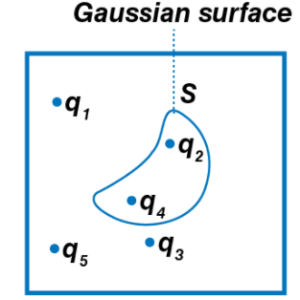Five charges

, and

are fixed at their positions as shown in the figure.

is a Gaussian surface. The Gauss’s law is given by

Which of the following statements is correct? a) E on the LHS of the above equation will have a contribution from q1, q3, and q5 while q on the RHS will have a contribution from q2 and q4 only b) E on the LHS of the above equation will have a contribution from all charges while q on the RHS will have a contribution from q2 and q4 only c) E on the LHS of the above equation will have a contribution from all charges while q on the RHS will have a contribution from q1, q3, and q5 only d) both E on the LHS and q on the RHS will have contributions from q2 and q4 onlyv

